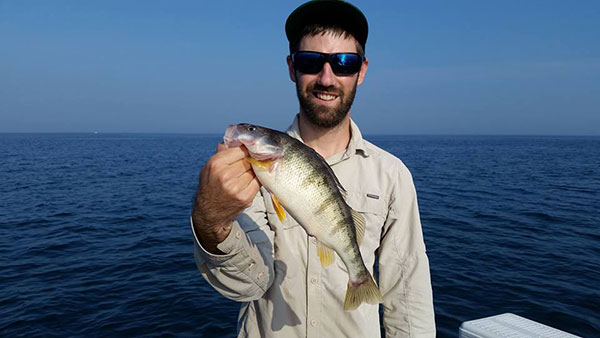By Louie Stout

We may be in dead of winter, but the impact of the weather over the next two months could have an impact on Lake Michigan perch fishery.
How so? Well, the past few winters were much milder and opened the door for remarkable perch fishing successes, especially in northwest Indiana waters.
Consider this – the Indiana DNR estimates some 70,000 perch were harvested in Hoosier waters last year– three times the 10 year average! Creel statistics show that 55 percent of those were taken in February and 35 percent in March. The remaining 10 percent were caught the rest of the year, with the bulk coming in July.
Milder weather in those early months enabled western Indiana anglers to get after a vulnerable adult perch population that groups up prior to the spawn.
Many of the perch caught there last year averaged a whopping 12 inches and are pre-spawn fish staging in deep clay flats in 50 to 60 feet of water.
Meanwhile, summertime anglers struggled, but Indiana Biologist Ben Dickinson believes that was largely due to weather patterns that pushed cold water farther offshore and away from traditional perch anglers.
The quality catches in late winter don’t seem to compute with DNR surveys that show spawn successes the last 10 or so years haven’t been very good.
“There was a great year class in 2015 and there have been a few blips here and there, but overall, not very good,” Dickinson said.
On the other hand, yellow perch growth rates have been phenomenal and that’s gotta please anglers. Biologists have found two-year-old fish that measure 6 to 8 inches.
“That’s nearly unprecedented in recent memory,” Dickinson noted. “Illinois has seen the same thing, so it’s the real thing.”
Why?
“It could be that there are fewer fish so there’s more food to go around, or that the food supply has increased,” he explained. “Or, it could be they are eating smaller alewives or more gobies. The average size of gobies has been knocked down considerably and to a size the perch could be eating.”
The biologist added that the survival rate of newly hatched perch may be surviving at a higher rate than they have in the past, “so it could be a multiple of things.”
Dickinson said surveys haven’t turned up many fish aged at 7 or 8 years old, which is unusual.
“The perch appear to be growing fast and dying younger,” he said.
Despite the big haul by early season perch jerkers last winter, the DNR’s adult perch survey last May turned up the second highest catch rate since 2010.
“We’ve had really good catches of adults in our spawner surveys the past five years,” said Dickinson. “They’ve run about five times higher than the previous decade.”
Lake Michigan has been iced up most of this winter, which likely will cut down on the early season harvest.
The bottom line is that – if Mother Nature provides stable weather this summer - perch anglers could land on a pile of jumbos.





